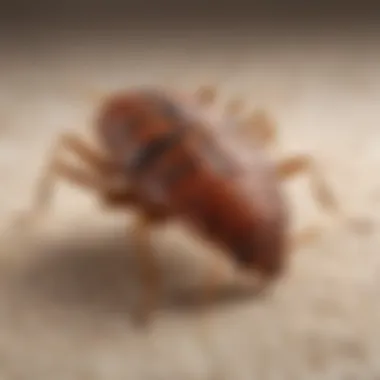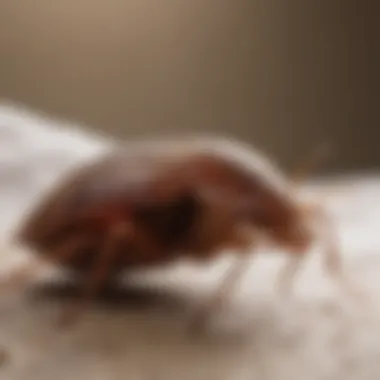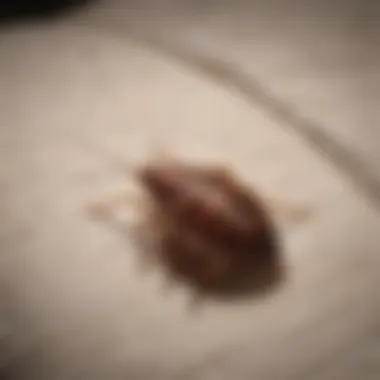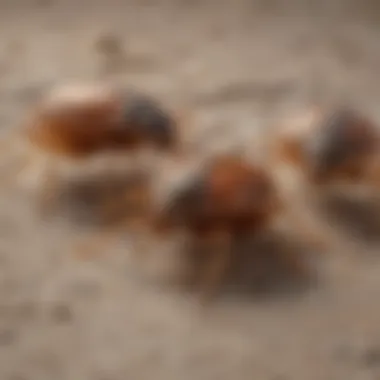The Longevity of Bed Bugs Without Blood: An In-Depth Analysis


Intro
Bed bugs, scientifically known as Cimex lectularius, have garnered significant attention due to their resilience and ability to thrive in various environments. Understanding how long these pests can survive without a blood meal is crucial for effective pest control and management. This article will analyze their biology, feeding habits, and the various factors affecting their longevity in the absence of blood.
Understanding Pests
The concept of pests encompasses a range of organisms that pose threats to human health, comfort, and property. Bed bugs fall squarely into this category due to their propensity to infest homes and cause discomfort through bites. They are not just an annoyance but can contribute to emotional stress and financial burden.
Definition of Pests
Pests are generally defined as organisms that are detrimental to human activities or health. They can include insects, rodents, and other animals that invade living spaces. Bed bugs specifically are known for their secretive nature and nocturnal feeding habits, making them particularly troublesome for homeowners.
Importance of Pest Identification
Identifying pests accurately is vital for effective control measures. Without proper identification, any interventions might be misapplied or incomplete. Bed bugs are often confused with other pests. Proper identification helps in implementing targeted strategies that can effectively reduce their populations while minimizing collateral damage to non-target species.
Longevity Without Blood Meals
Bed bugs are remarkable in their ability to endure long periods without feeding. Adults can survive for months or even longer in favorable environments. Their adaptability is partly due to their unique metabolic adaptations.
Physiological Adaptations
During periods without a blood meal, bed bugs can slow down their metabolism significantly. This adaptive response allows them to conserve energy and maximize their survival duration. Factors like temperature and humidity can further influence their dormancy and survivability.
"Bed bugs can live for several months without feeding, demonstrating significant resilience to starvation."
Metabolic Rate
The metabolic rate of bed bugs changes dramatically in response to the availability of food. When deprived of blood, their body functions slow down, thereby reducing their energy needs significantly. This efficiency is key to their ability to endure extended periods without nourishment.
Implications for Pest Control
Understanding how long bed bugs can last without a meal has important implications for pest control strategies. Conventional methods may fall short if they do not consider the pest's resilience. Effective pest management requires a holistic understanding of bed bug biology and behavior.
Integrated Pest Management Approaches
Implementing Integrated Pest Management (IPM) strategies allows for a more comprehensive approach to dealing with bed bugs. Such strategies might integrate biological control, environmental modifications, and cultural practices to reduce bed bug populations comprehensively. Recognizing the biology and feeding patterns of bed bugs is crucial in formulating these effective strategies.
By understanding the surprising longevity of bed bugs without blood meals, homeowners and pest management professionals alike can develop targeted approaches that address infestations more effectively.
Understanding Bed Bugs
Understanding bed bugs is crucial for anyone dealing with pest management. Knowledge about their biology and behavior can significantly impact the effectiveness of control strategies. This section highlights key elements such as biological characteristics, life cycles, and feeding habits that contribute to a comprehensive understanding of these pests. This knowledge is not just academic; it has direct applications in managing infestations efficiently.
Biological Characteristics


Bed bugs, scientifically known as Cimex lectularius, are small, reddish-brown insects. They are nocturnal and feed primarily on blood, often from humans. One of their most notable biological features is their ability to detect carbon dioxide and body heat, which guides them to hosts. They possess a flat body shape, allowing them to hide in narrow spaces, a crucial survival trait. This biological adaptation is significant as it influences how easily they can infest living spaces.
Furthermore, bed bugs have a remarkable capacity for resilience. They can survive various environmental conditions, which contributes to their longevity. Their size and physiology play a role in their adaptability to different situations, including periods without food.
Life Cycle of Bed Bugs
The life cycle of bed bugs consists of three main stages: egg, nymph, and adult. Each stage presents unique challenges and highlights important aspects of bed bug survival.
Egg Stage
The egg stage is vital in understanding bed bug populations. Female bed bugs can lay up to five eggs per day, with each egg measuring about 1 mm in length. This high reproductive rate ensures quick infestations, making them a significant concern for households. The eggs are often laid in hidden areas, making detection difficult for homeowners.
A key characteristic of this stage is the egg's protective coating, which offers some resistance to environmental factors. The ability of the eggs to survive in various conditions can lead to significant population growth if not addressed early.
Nymph Stage
The nymph stage refers to immature bed bugs that gradually develop into adults. Nymphs undergo five molts before reaching maturity. During this stage, they actively seek blood meals to facilitate their growth. Understanding the nymph stage is crucial, as these life forms are often less noticeable than adults yet capable of causing similar effects on host health.
Nymphs are small and translucent, which can make them difficult to spot. This concealment can contribute to infestation resilience, enabling them to thrive unnoticed until the population is substantial.
Adult Stage
The adult stage represents the fully grown bed bug that is likely to be encountered by homeowners. Adults can survive for several months without blood, a quality that underlines their persistent nature. They have a characteristic flat, oval shape and can reach up to 5 mm in size.
One significant feature of adults is their longevity and ability to thrive under various circumstances. Adult bed bugs are also known for their capacity to reproduce quickly, compounding any issues businesses and homeowners face during an infestation. This adaptability can make control measures more challenging, underscoring the importance of a thorough understanding of their life cycle.
Feeding Habits of Bed Bugs
Understanding the feeding habits of bed bugs is essential for grasping their survival strategies. Bed bugs rely on blood meals to grow and reproduce, making their feeding behavior a pivotal aspect of their biology. The efficiency and frequency of these meals directly affect their lifespan and ability to endure periods without sustenance. This section aims to dissect the intricacies of bed bug feeding, emphasizing methods and frequency.
Methods of Feeding
Bed bugs adopt a specific approach when it comes to feeding. The primary method involves piercing the host's skin using specialized mouthparts known as proboscis. This structure allows them to extract blood while simultaneously injecting saliva that contains anticoagulants. These anticoagulants ensure the blood continues to flow freely, making it easier for the insect to feed.
When feeding, bed bugs typically inject enzymes that numb the area, which helps mask their presence from the host. This method not only facilitates the feeding process but also minimizes the chance of detection. They often feed while the host is asleep, making their feeding behavior highly strategic. The duration of a feeding session can range from 5 to 15 minutes, depending on the individual bug and the host's blood flow.
Frequency of Feeding
Bed bugs have the ability to survive several weeks without a blood meal, but their feeding frequency plays a crucial role in their life cycle. On average, bed bugs need to feed every 5 to 10 days to maintain optimal health. Factors such as temperature, humidity, and the bug's developmental stage influence how often they seek out a meal.
Interestingly, adult bed bugs may require more frequent meals than their younger counterparts. For example:
- Nymphs: These younger bed bugs require feeding more frequently during their developmental stages, particularly after each molt.
- Adults: They tend to limit their feeding to every week or longer when conditions are less favorable.
Under extreme circumstances, such as low temperatures or inadequate hosts, bed bugs can enter a state of dormancy, further extending their survival duration without feeding. For pest management, knowing these feeding patterns is vital. Effective control strategies can be timed according to their feeding behaviors, ensuring better results in managing infestations.


Survival Without Blood
The concept of survival without blood is central to understanding the resilience of bed bugs. This section examines how long these pests can persist without a blood meal, illustrating their impact on pest management strategies. This knowledge is crucial for those dealing with infestations, as recognizing the limits of bed bugs’ survival can guide effective control measures.
Duration of Survival
General Findings
Bed bugs can survive for extended periods without feeding, depending on various conditions. Research suggests that adult bed bugs can live for several months without a blood meal. One key characteristic is their ability to enter a state of dormancy. This behavior enables them to conserve energy until a suitable feeding opportunity presents itself.
The overall importance of general findings lies in understanding how different life stages react to starvation. Adult bed bugs are more resilient compared to nymphs. The unique feature of these findings is their applicability in real-world pest control scenarios. By knowing how long bed bugs can withstand hunger, homeowners can tailor their eradication efforts more effectively.
Specific Studies
Numerous specific studies contribute to our understanding of bed bug longevity. For instance, one study conducted by scientists at the University of Kentucky indicated that adults could survive up to 400 days without feeding under optimal conditions. This key characteristic highlights the significant adaptability of these insects.
Such studies are valuable for pest management professionals. They inform treatment timing and strategies. Unique features of these specific studies include controlled laboratory conditions that, while not exactly replicating real-world scenarios, provide critical insights into the limits of bed bug survival. However, the disadvantage is that these findings may not fully account for environmental variations that can affect real-life situations.
Metabolic Adaptations
Metabolic adaptations play a critical role in how bed bugs endure extended periods without food. These adaptations involve slowing down their metabolic processes, allowing them to conserve energy. When deprived of blood, bed bugs efficiently manage their resources, utilizing stored fat to sustain themselves over time. It ensures their survival during periods when hosts are not available.
Furthermore, their ability to lower their activity levels reduces their energy expenditure, enabling them to survive until their next feeding. Knowledge of these adaptations is essential for developing effective pest control measures, as it suggests that eradication efforts may require patience and multiple interventions.
Environmental Factors Affecting Survival
Understanding how environmental factors impact the longevity of bed bugs without a blood meal is crucial for both homeowners and pest management professionals. Bed bugs, known for their resilience, can significantly alter their survival capabilities based on external conditions. Addressing factors such as temperature, humidity, and oxygen availability helps to gauge how these pests might endure periods without feeding. This understanding is integral for developing effective control strategies and for mitigating the risks associated with infestations.
Temperature Influence
Temperature plays a pivotal role in the survival of bed bugs. Higher temperatures can speed up their metabolism, leading to increased feeding frequency and reproduction rates. Conversely, lower temperatures can slow their metabolic processes. In environments where the temperature fluctuates dramatically, bed bugs may enter a state of suspended animation.
Research findings suggest that bed bugs can survive longer periods without feeding in cooler temperatures, as their metabolic demands decrease. For instance, at around 13 degrees Celsius (55 degrees Fahrenheit), bed bugs can enter a dormant phase, prolonging their lifespan significantly without a blood meal.
However, excessive heat, especially above 45 degrees Celsius (113 degrees Fahrenheit), can incapacitate or kill bed bugs. Understanding these temperature thresholds is crucial in managing infestations, as targeted temperature manipulations can serve as a practical method in extermination efforts.
Humidity Levels
Humidity is another significant environmental factor influencing the survival of bed bugs. Bed bugs thrive in environments with moderate humidity, generally around 50% to 80%. Adequate moisture levels are essential for bed bug survival, as they can expel moisture during feeding.
Low humidity conditions stress bed bugs, leading to dehydration and potential mortality. Studies indicate that in environments with relative humidity below 30%, adult bed bugs may not survive beyond a few days. Conversely, high humidity can enhance their survival periods, allowing them to sustain themselves without feeding for more extended periods.
Household environments can fluctuate in humidity based on factors like ventilation and seasonal changes. Recognizing these conditions and implementing dehumidifiers or other moisture control methods can help create a less hospitable environment for these pests.
Oxygen Availability


The availability of oxygen also impacts the survival duration of bed bugs without a blood meal. Bed bugs are efficient at utilizing available oxygen; however, they can tolerate low-oxygen environments for some time. This adaptability enables them to survive in tight spaces often found in homes, such as in mattresses, furniture, or cracks in walls.
Research indicates that prolonged exposure to low oxygen levels can adversely affect their survival and longevity. In experimental settings, bed bugs have shown reduced lifespan when oxygen concentrations are severely limited. Adequate ventilation is important in managing infestation risks, as ensuring sufficient airflow can potentially hinder bed bug survival strategies.
In summary, the interplay of temperature, humidity, and oxygen availability can significantly affect the longevity of bed bugs without a blood meal. Understanding these factors provides essential insights for effective pest management and control strategies.
By recognizing and modifying environmental conditions, homeowners can create less favorable habitats for bed bugs, ultimately reducing their chances of survival.
Implications for Pest Management
Understanding the longevity of bed bugs without a blood meal has significant implications for pest management strategies. By appreciating how long bed bugs can survive in various conditions, pest control professionals and homeowners alike can develop more effective practices to combat these infestations. Effective pest management hinges on timing, understanding the behaviors of these pests, and utilizing appropriate treatment protocols.
Timing Treatment Protocols
The timing of pest control measures is crucial in managing bed bug populations effectively. Knowing that bed bugs can survive for months without feeding allows for better scheduling of treatments.
- Early Detection: Timely inspections can limit the spread of an infestation. Being proactive rather than reactive is essential.
- Targeted Interventions: Pest management efforts should coincide with the bed bug life cycle phases. Applying treatments before peak reproductive periods can diminish overall populations.
- Follow-Up Treatments: Since bed bugs can withstand periods without meals, follow-up treatments become vital. Regular monitoring after initial extermination efforts can prevent resurgence.
Utilizing targeted treatments at optimal times minimizes the chance for these pests to thrive, therefore enhancing the efficacy of pest management protocols.
Understanding Infestation Dynamics
Grasping the dynamics of bed bug infestations informs pest management strategies. Bed bugs exhibit specific behaviors influenced by their survival needs.
- Hiding Habits: Bed bugs tend to seek out sheltered spots, making physical inspections difficult. Understanding these habits assists in identifying potential hiding places.
- Reproduction Rates: Female bed bugs can lay numerous eggs, leading to rapid population growth. Recognizing this aspect can motivate homeowners to act quickly upon discovery.
- Resilience to Treatments: Knowledge of bed bug resistance to certain chemicals influences the choice of treatment methods. Understanding these factors enables the development of integrated pest management plans that can adapt to changing conditions.
"Effective pest management requires a combination of knowledge and strategy tailored to the behaviors and survival tactics of the pests in question."
The insights gleaned from understanding infestation dynamics can significantly aid homeowners in taking preventive measures before infestations escalate. This comprehensive approach ensures efficient resource allocation and more successful outcomes in pest control efforts.
Recent Research and Advances
The exploration of bed bugs' resilience in the face of prolonged starvation has attracted significant academic interest lately. Recent research underscores critical insights into bed bug survival strategies that offer valuable implications for pest management. By examining the longevity of these pests without blood meals and their metabolic adaptations, experts can develop more effective control strategies. This section will discuss newer findings and propose future research avenues that can greatly enhance understanding and treatment methodologies against bed bug infestations.
Novel Findings
Recent studies have illuminated various factors that contribute to the extended survival of bed bugs without feeding. One major finding has been that bed bugs can endure long periods—often several months—without blood.
The metabolic rate of bed bugs is notably adaptive. Researchers have identified that bed bugs significantly lower their metabolic rate when food is scarce. By adjusting their energy consumption, they deter rapid starvation and extend their lifespan. Some studies indicate that, in controlled environments, bed bugs can survive at least six months without a blood meal under optimal conditions.
"Understanding the metabolic adjustments in bed bugs can help formulate pest control strategies that target their survival mechanisms." - Leading Entomologist
A noteworthy study published in the "Journal of Medical Entomology" revealed that adult bed bugs maintained themselves by utilizing stored fat reserves. This implies that infestations could rebound even after prolonged treatment if not addressed comprehensively.
Additionally, research surrounding the impact of environmental variables has shown that temperature and humidity greatly affect their longevity. For instance, bed bugs thrive in warmer environments, which allows them to adapt quickly even when deprived of food. Furthermore, certain conditions can accelerate their lifecycle and enhance reproductive capabilities once feeding becomes available again.
Future Directions in Bed Bug Research
The findings from recent studies necessitate further exploration into various aspects of bed bug biology and behavior, aiming to refine pest management tactics.
- Exploring Genetic Factors: Understanding the genetic adaptations that enable bed bugs to survive extended periods without blood can open up new avenues for targeted pest control.
- Behavioral Studies: Investigating the behavioral patterns of bed bugs in response to starvation can reveal weak points to exploit during treatment.
- Chemical Resistance: Research focusing on the increasing chemical resistance in bed bug populations is critical. New studies must address how to counteract evolving pesticides and develop effective alternatives.
- Field Studies: Conducting longitudinal studies in varied settings to gauge the impact of real-world environmental pressures on bed bug survival can improve pest management protocols.
- Collaboration Across Disciplines: Engaging ecologists, entomologists, and psychologists can provide a multi-faceted approach to studying bed bug resilience.



